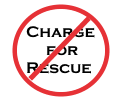How To Avoid Getting Struck By Lightning
Thunderstorms bring lightning, a powerful force that can result in death.
Though most common June through September, thunderstorms can happen any time of the year. During July through September, the North American monsoonal weather pattern can cause moisture from the Gulf of California to flow into the Sierra Nevada, resulting in thunderstorms.
Ultimately, there is no safe shelter outside. The only safe place is in a substantial building or hard-topped vehicle.
Plan Ahead
- Check the weather forecast.
- Watch for the afternoon build-up of cumulus clouds. Seek shelter or go to lower elevations if you see towering thunderheads, darkening skies, increased wind, or thunder and lightning.
Thunderstorms are most common in the afternoon. Thunderstorms often develop when the sun heats the air near the ground and pockets of warmer air start to rise in the atmosphere. Mountain ridges and peaks contribute to updrafts that fuel thunderstorms. As these pockets of air rise, cumulus clouds form. These clouds grow vertically and become towering cumulus, and may be one of the first signs of a developing thunderstorm. The final stage of development is when anvil-shaped clouds, known as cumulonimbus form. These clouds are higher and wider and are associated with lightning. - Even if a thunderstorm is approaching from far away, descend as far and fast as you can before taking shelter.
Count the seconds between the flash of the lightning and the sound of the thunder; divide the number of seconds by five to get a very rough estimate of the distance (in miles) that the lightning storm is away from you. - Consider postponing a hike in order to avoid lightning. When planning your trip to Yosemite, include time for alternative activities during severe weather. Alternative activities include scenic driving, taking a bus tour, or spending time indoors at visitor centers and museums.
During a Thunderstorm
Once you are on the trail or out in the open, maintain situational awareness. Watch for the afternoon build-up of cumulus clouds. At the first sign of an impending storm, such as towering cumuliform clouds, darkening skies, increased wind, or thunder and lightning, get to lower elevations and get inside a substantial building or hard-topped metal vehicle.

If you hear the rumble of thunder, a thunderstorm is within 10 miles (16 km). Do not wait; this is a warning you that you need to get to a safe place immediately. Remember: When Thunder Roars, Go Indoors! Avoiding a thunderstorm before one arrives it the best way to stay safe. If you’re unable to avoid a thunderstorm, here are some additional tips.
- Avoid viewpoints.
- Avoid tall, isolated, or solitary trees, water, metal, and power lines.
Lightning often strikes the tallest object in the area. - Find an open, low space on solid ground. If you’re in the forest with no clearing, position yourself under the shortest trees you can find.
Seek a place sheltered from direct strikes (avoid high points and tall objects) and ground currents (avoid tree roots). - Remove metal objects and electrical devices from your body.
- Avoid water-related activities.
- Avoid open vehicles.
- Avoid vault toilets.
- Space yourself at least 50 feet from your hiking companions.
This minimizes the chances that everyone will be struck by lightning, allowing some members of your group to render first aid and/or get help. - As a last resort, make yourself a small target by crouching on your toes with your hands covering your ears. Touch the ground as little as possible; the ground conducts electricity. Do not lie flat.
- Remember, the only safe place is inside a substantial building or hard-topped vehicle. Stay alert in a safe location until 30 minutes after last thunder.
If in the wilderness, when thunderstorms are possible, plan to hike or climb above the treeline in the morning. Plan to summit peaks prior to noon. Avoid the most dangerous places and activities.
Even if a thunderstorm is approaching from a long distance, descend as far and fast as you can to minimize the risk of being struck. The National Weather Service has more risk management information for hikers and backpackers [5 MB PDF].
In case of an emergency, remember that a lightning victim is safe to touch and, if trained, you should attempt to resuscitate a person who is not breathing or has no pulse as soon as possible.



